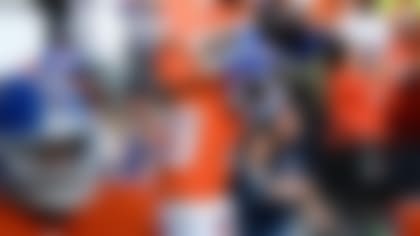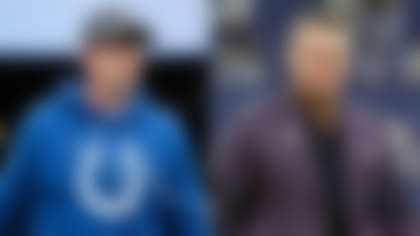With the 2015 NFL Draft in the books, NFL Media reporters share the insightful nuggets and bites of interesting information they gathered during a weekend rich with both. Scroll down or click below to see reports about the following teams:
Cleveland Browns: Grounding the offense
The Cleveland Browns did not draft a quarterback. But it's not as if they didn't consider it. General manager Ray Farmer told me that it was more about not over-drafting a QB relative to where the team had him rated on its draft board.
Farmer said the Browns have faith in their current quarterbacks, Johnny Manziel, Josh McCown, Thad Lewis and Connor Shaw. That faith might only extend so far, however. Several people with the organization said they aren't going to put too much on the quarterback. This is going to be a run-based/short passing-game team. That is why the Browns drafted offensive lineman Cameron Erving 19th overall, along with running back Duke Johnson (Round 3) and tight ends Malcolm Johnson and Randall Telfer (both in Round 6). One member of the front office told me that whoever lines up at quarterback is going to be doing a lot of handing off. Look for Cleveland to model itself after the Rex Ryan-era Jets.
Don't do it small:Jameis Winston appeared at his draft party around eight minutes before the Buccaneers called to tell him they were going to draft him -- he had been at the party earlier but went home to change. As soon as he entered the living room where his family was waiting, he said loudly, "If we're going to do it, do it big."
Fast forward to Friday, at the Cleveland Browns' news conference introducing first-round picks Danny Shelton and Erving. Erving, Winston's former teammate at Florida State, was asked if there was a moment when he realized how special Winston was. Erving said that in the national championship game two seasons ago, as Auburn was kicking off after taking a late lead, Winston came over to the offensive line on the sideline and screamed, "If we're going to do it, do it big." So either that is Winston's catchphrase or his credo.
-- Steve Wyche (@wyche89)
New York Jets: Draft day seized
New York Jets GM Mike Maccagnan told the media and his colleagues in the draft room to expect the unexpected in the draft. The Jets lived that reality in Thursday's first round, when defensive lineman Leonard Williams was available at No. 6 overall.
Maccagnan, committed to considering all trade offers, worked the phones before turning in the pick as the clock wound down. In his first draft as a general manager, he made the selection without doubt on two fronts: He was choosing the best player available, and he also was adding to a position where the Jets had no need.
"You really can't have enough good football players," he later told reporters. "So it really doesn't matter what position you go after."
The selection of Williams eventually might change the fate of defensive lineman Muhammad Wilkerson, who has been the Jets' best player the past two seasons. Wilkerson is not attending voluntary team activities, but he did, via Instagram, publicly welcome Williams to the Jets.
Scheduled to make $6.97 million in 2015, Wilkerson is seeking a long-term deal. He loses considerable leverage with the arrival of Williams. But for the 2015 season, the Jets anticipate having Wilkerson on their roster and creating havoc with Williams and Sheldon Richardson alongside him.
Williams, who many believed was the surest bet in the draft, was surprised to fall to six. When he talked to Todd Bowles after the selection was made, Williams said the coach reminded him, "I told you if you dropped to the Jets, I was going to get you."
"He stayed true to his word, "Williams said, "so I appreciated it."
It's unlikely the Jets ever thought they had a shot at Williams. Neither Maccagnan nor Bowles attended USC's pro day; they sent defensive line coach Pepper Johnson. (Bowles did attend Florida's. The Jets liked Dante Fowler Jr.)
Williams provides the Jets with an embarrassment of riches along the defensive line, as Wilkerson and Richardson are both former first-round picks.
While there is some question as to how Bowles will use all three players, there is no doubt he'll find a way. The Jets will run a 3-4, but they're multiple. Last season, when Bowles, as the Arizona Cardinals' defensive coordinator, was facing a Tony Romo-less Cowboys squad, he used four defensive linemen for most of the game, holding DeMarco Murray to less than 100 yards for the first time that season.
The Jets' defense could -- and should -- be among the best in the league. In Williams, the team was presented with an opportunity it could not pass up.
Bowles, whose Cardinals blitzed 43 percent of the time last season, has a creative defensive mind. The possibilities now are endless, particularly when it comes to disrupting opposing quarterbacks.
"I definitely want a sack before that," he said.
-- Kimberly Jones (@KimJonesSports)
Philadelphia Eagles: Kelly in the saddle
This was Chip Kelly's first NFL draft as THE decision maker. And at no point during the three-day-long event did he publicly appear weighed down by the pressure -- or particularly juiced by the power.
"I wouldn't say it was either of those," Kelly said, seconding the outside observation. "I just think you're trying to make logical decisions in terms of what you're doing, and you've got to really rely on the work you've done up until it."
Kelly was both aggressive (moving up in the second round, to nab cornerback Eric Rowe) and patient (staying pat in the third, when he added linebacker Jordan Hicks). Kelly engineered two trades, followed a somewhat expected script in shoring up his defense and didn't make the one wildly expensive move the citizens of Philadelphia so fervently hoped for: trading up for former Oregon quarterback Marcus Mariota. Kelly very coolly compared the Titans' price for the second overall pick to that of a ritzy house outside his budget. One of his assistants, two days after the first round, scoffed that Philly never came close: The ask was so high, he said, the Eagles didn't even bother trying to cobble together a specific package.
Afterwards, Kelly said he was especially pleased with how organized and orderly (a word he used repeatedly) the draft was, crediting director of player personnel Ed Marynowitz for that. He said his role wasn't all that different than in years past.
"I didn't run the show, I just had the final decision, so my role never really changed," he said. "If it comes to between Player A and Player B, then I had to break the tie."
Executive vice president of football operations Howie Roseman, who was relieved of personnel duties when Kelly's were added, was in the draft room and "advising us," Kelly said.
Bradford's best yet to come? One offensive coach at the Eagles' headquarters rolled his eyes at all the Sam Bradford trade talk. His appreciation and assessment of the snake-bitten ex-St. Louis Rams quarterback are both high. "People have no clue how good he is," he said.
Coaches will get their first official look at Bradford throwing -- and moving on his surgically-repaired ACL -- on Monday.
Always thinking: Several times during the draft, Kelly referred to Stanford psychology professor and author Carol Dweck, who has extensively studied and written about human motivation. He talked about whether his draft picks had a fixed mindset (static intelligence) or growth mindset (intelligence that is constantly developed), and the obviously well-read coach's stamp was on this class for sure: Every pick, save for the first, is either a college graduate or a senior set to graduate. (That first-round selection, USC junior Nelson Agholor, was the draft's only simultaneous football All-American and Academic All-American.) Third-rounder Jordan Hicks graduated in three years and is working on his master's degree.
"It's something that you look at," Kelly said, acknowledging that report cards are indeed relevant to him. "To me, because it's a sign of commitment, have they set out and done something that they invested in and then said, 'Hey, I followed through with it and I did it.' So I always look at it as a positive.
"That's just another kind of way to evaluate players in terms of commitment, the ability to stick to things, to set out and make goals and kind of stay with those goals."
-- Aditi Kinkhabwala (@AKinkhabwala)
San Diego Chargers: Short list included seven players
The Chargers started the draft with one goal: Get a difference-maker, a playmaker opponents would have to scheme against. When the Miami Dolphins picked receiver DeVante Parker at No. 14 overall, they had effectively taken the sixth of the Chargers' seven designated impact players off the board. "It was a little tense," GM Tom Telesco said of the draft-room atmosphere. "We had about 14 players we felt good about. But out of that 14, we felt like there were seven that would come in and make an impact. Melvin (Gordon) was one of those seven."
With only Gordon left, San Diego scrambled to put together a trade with the San Francisco 49ers to move up two spots in the first round to No. 15 and snatch the runner. The pick not only improved the Bolts' overall offense, but maybe more importantly, it sent a message to quarterback Philip Rivers, who was at the center of trade rumors leading up to the draft. Telesco thinks that, of all the running backs available, Gordon was the best pass protector. "In college, they don't get a lot of opportunities to protect in the backfield. He has a willingness to do it -- he's tough and he's smart," Telesco said. "Part of pass protecting at our level is to be able to see who is coming and know who to pick up ... and he can do it."
The move wasn't lost on Rivers. He was at the facility Friday, an off day for the Chargers, to welcome Gordon to the team.
Offensive line not a priority: The Chargers have struggled with depth on the offensive line for a few years now. Even though they added guard Orlando Franklin during free agency and re-signed tackle King Dunlap, most people thought the team would target this area in the draft. San Diego didn't.
Telesco said in his post-draft news conference that, while people outside the building might think the team needs more players along the offensive line, the organization feels good about who it has on the roster.
The Bolts did address the position immediately after the draft, adding three undrafted free-agent linemen: Ben Beckwith (guard out of Mississippi State), Tyreek Burwell (tackle out of Cincinnati) and Cameron Clemmons (tackle out of Western Kentucky). Will one of those guys stick? Judging by San Diego's 2015 draft selections, the Chargers appear content to play D.J. Fluker at right tackle rather than kicking him inside to guard. Fluker and Dunlap are the projected starting tackles, with Franklin at left guard and Johnnie Troutman at right guard.
Another linebacker in Round 2: Could San Diego's linebacking corps define the success of Telesco's tenure? For the third year in a row, he selected a linebacker in the second round. Last year, it was Jeremiah Attaochu (No. 50 overall); the year before, it was Manti Te'o (No. 38). This year, Telesco selected Miami's Denzel Perryman on Day 2 at No. 48 overall. (He also drafted North Dakota State's Kyle Emanuel in Round 5).
New linebacker coach Mike Nolan has the task of getting production out of what should be a talented group ... at least based on where they were drafted.
- -- Alex Flanagan @AlexFlanagan*
San Francisco 49ers: Baalke clearly in charge
As San Francisco 49ers GM Trent Baalke strode to the podium for his sixth post-draft news conference, there was no mistaking who's running the show in Santa Clara. Not that we needed any clarification after Baalke "won" the so-called power struggle with Jim Harbaugh. There he was, in his Tiger Woods-like Sunday red polo and black slacks -- the fact that this was actually a Saturday was of no consequence to Baalke, who carried himself as victoriously and confidently as the golfing great has done on the last day of 14 major championships. Just as Woods has shown a less demonstrative personality recently, perhaps we're starting to see a calmer Baalke. His poise and focus certainly contrasted with what we saw from the man in December, inside the CenturyLink Field press box, literally pounding on the table at which he sat, louder and louder and louder as the 49ers' struggles mounted in their eventual loss to the rival Seahawks.
Maybe Baalke appears different because his relationship with his head coach is different. Jim Tomsula spoke glowingly about Baalke's mastery of the draft board; he was as complimentary as a sci-fi film fan describing Morpheus' manipulation of the Matrix. Tomsula painted a picture inside the draft room of Baalke in full command of his game day, with all analysis, equations and potential maneuvers at the ready. A process Tomsula said he learned more from this year than he contributed to -- his first draft in the head coach's chair. While Tomsula said he was more involved in draft preparation as head coach, he told me he probably wouldn't look to be more involved next year. Tomsula did admit he was hoping Baalke might have made a couple of different choices to balance the team's depth -- the 49ers now have eight tight ends on their roster, for example -- but says this experience taught him that he'd have to work in personnel 365 days a year to have the precision needed to be successful during draft week.
While Baalke's relationship with Harbaugh might have been contentious, if not controversial, his relationship with Tomsula might best be described as one in which both men clearly know their roles within the organization. How this draft class pans out or whether the 2015 49ers become the first team to play a Super Bowl game in its home stadium are questions that won't be answered for a while. But we do know Baalke will be the one getting the credit -- or the blame.
-- Omar Ruiz
Tampa Bay Buccaneers: Time to turn to texts
The images of NFL war rooms suggest that general managers are cloistered within, communication cut off from the outside world, concerned only with the draft board in front of them.
Not exactly.
The draft, after all, contains long stretches of inactivity interrupted by bursts of decision making. That gives GMs plenty of time to do things like text reporters asking for NHL playoff updates, as happened to me on the second and third days of the draft. (The New York Rangers, it turns out, have fans in front offices.)
Or to take texts from their fathers, like Tampa Bay GM Jason Licht did on Saturday. Licht was sitting in the draft room when a text from his dad arrived. He showed it to coach Lovie Smith. The message: You have to draft Nebraska receiver Kenny Bell.
"So that was easy, we turned the card in right then," Licht said, with a laugh. "My dad, Ron, he's had season tickets there since 1962, so I get all the Nebraska intel that I need."
The Bucs did draft Bell, of course, and Licht's dad was right -- they did have to. Licht grew up in Nebraska, and played linebacker and guard for the Cornhuskers before transferring to Nebraska Wesleyan University, where he was an all-conference defensive tackle. And Licht called Bell one of the best receivers ever to come out of Nebraska. He ran a 4.34-second 40-yard dash in a workout for the Bucs, showing the kind of speed that should help Jameis Winston stretch the field. Bell is likely to start out in a receiver rotation, but Licht said he hopes he will eventually start.
-- Judy Battista (@judybattista)
Tennessee Titans: Standing up to the pressure
About 45 minutes before the clock started on Tennessee's highly coveted second overall pick, Titans general manager Ruston Webster couldn't have been cooler. When I mentioned the rumors about the Eagles' pursuit of the Buccaneers' top pick -- which, if successful, would've guaranteed Chip Kelly's reunion with Marcus Mariota -- Webster didn't flinch. "I feel very good about both quarterbacks," he said. "I don't think I can go wrong."
This was the first time, based solely on instinct, that I realized Webster wasn't bluffing. This wasn't a scare tactic, a smokescreen or a leverage point. He wanted one of the two quarterbacks, and regardless of a late, unexpected push by the Bears, he was going to get one.
Webster told me after the draft that receiving the overtures from other teams served as nothing more than confirmation of what he believed: that Mariota was worth the pick.
Spatial memory: Perhaps the biggest (and best) reason to believe the Titans would be willing to deal the pick was that the style of play of Mariota -- a product of the spread option -- seemed an unlikely fit for coach Ken Whisenhunt's pro-style system.
But Whisenhunt provided a pretty convincing explanation as to why Mariota could work in any scheme: something called "spatial memory." As Whisenhunt explained it, Mariota essentially has football's equivalent of a photographic memory.
"You say, 'What's spatial memory?' " Whisenhunt said. "He remembers plays. He remembers fronts. He remembers things in the short term and the long term.
"We're talking about an unbalanced set that USC ran against (Mariota's Oregon team) three years ago. Like, 'Oh yeah, that was in this game at this time.' Those are the kinds of things, to me, that are important for that position. You have to have a memory that can see everything and remember it, because when it happens in a game, then you have to come over and communicate that on the sideline, you have to have a plan (for) how you're going to adjust."
During his introductory news conference, an otherwise humble Mariota seemed incredibly confident when posed with the possibility of starting Week 1 -- a big task, given how much he'll need to digest between now and then. It's hard to think this confidence isn't attached to his natural ability to consume information.
DGB connection: I'd heard from sources very early Friday, once teams had a chance to rearrange their draft boards in the wake of Day 1, that Tennessee was very interested in landing wide receiver Dorial Green-Beckham.
There were plenty of questions about Green-Beckham's checkered past, including failed drug tests and an accusation of violence, but one source close to Green-Beckham made a strong case for him with this quote:
"He has renewed my hope in professional athletes, especially ones that screw up."
The Titans did plenty of research -- and had the blessing of ownership -- before drafting Green-Beckham. They also felt comfortable enough to pick him given the moderate stretch of time that has passed since his last incident (he was dismissed by Missouri on April 11, 2014).
*-- Jeff Darlington (@JeffDarlington) *
Washington Redskins: Improvising according to plan
The Washington Redskins' dream scenario had Dante Fowler Jr. (rather than Leonard Williams) falling in their lap -- but the consolation prize wasn't so bad.
And in the end, new GM Scot McCloughan was able to accomplish three goals he set out going into the process. He fortified the lines of scrimmage. He added picks. And he used those picks to add size and build a sturdier middle class to the roster.
Fowler -- who went third overall to the Jacksonville Jaguars -- was not only the top-ranked player on Washington's board, he was also targeted by other teams with designs on trading up. In the week leading up to the 2015 NFL Draft, the Redskins, who held the fifth overall slot, had discussions with a number of teams within the top 15, but most of those talks were predicated on Fowler being there. Had the Florida star fallen to No. 5, the Redskins would've had the choice of either taking the guy they believed was the best player in the class or dealing off the pick for a very healthy package of selections.
As it was, Fowler went third, and the second guy on the Redskins' board (receiver Amari Cooper) went fourth, to the Raiders. That left Iowa offensive lineman Brandon Scherff as the top player available, as McCloughan had ranked them. So the 'Skins pulled the trigger there on a player they believe can play all five line spots -- they'll start him out at right tackle but believe his best position may be right guard -- then got their edge rusher, and another versatile piece, in Mississippi State's Preston Smith with the 38th pick.
After adding one building block to each line, McCloughan used the 69th pick to execute the other part of his plan: Turning the seven picks they took into the draft into more, so Washington could supplement a roster that needs numbers. McCloughan pulled off a trade with his old boss, Seahawks GM John Schneider, to seize three more picks, in exchange for moving back 26 spots.
From there, the Redskins added more size at positions like tailback (230-pound Matt Jones, whose running style they see as being similar to that of Marshawn Lynch) and guard (Alabama's Arie Kouandjio). And the goal -- to add big, physical, versatile players -- was accomplished across the board.
So things didn't go exactly how the Redskins would've liked them to in McCloughan's first draft with the team. But with the knowledge that draft days rarely play out as planned, the final results were pretty good.
-- Albert Breer (@AlbertBreer)



